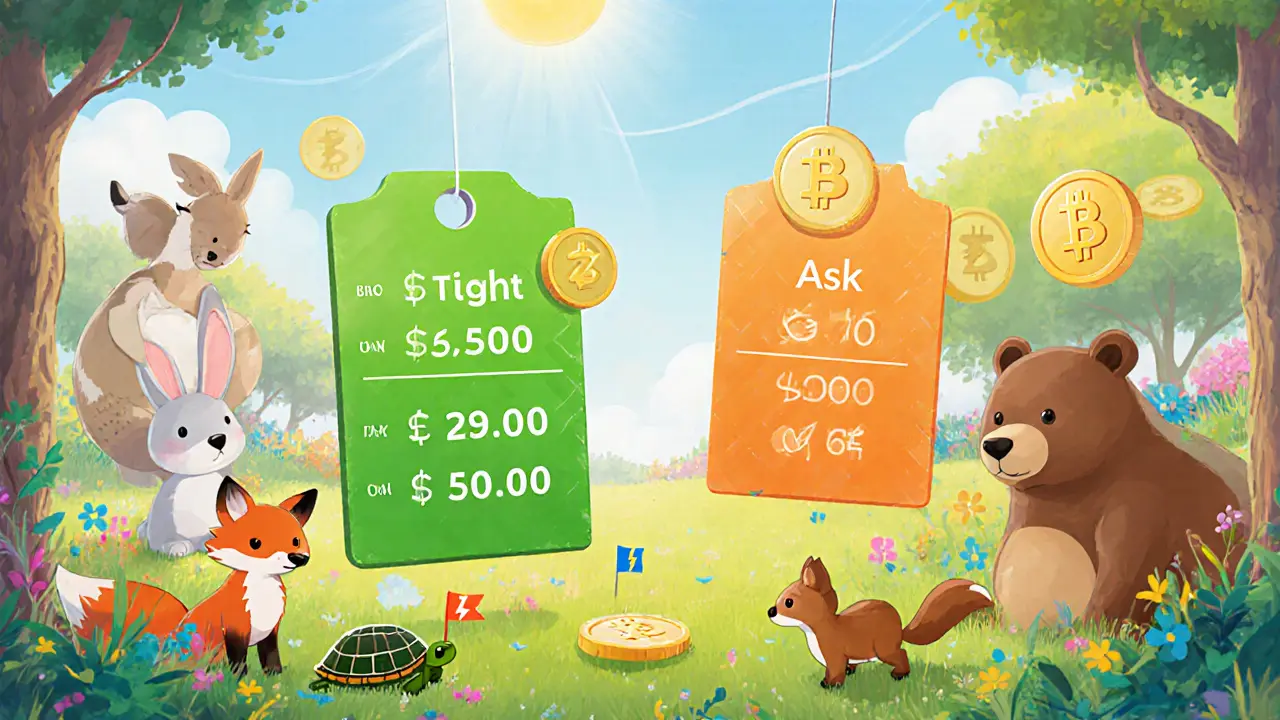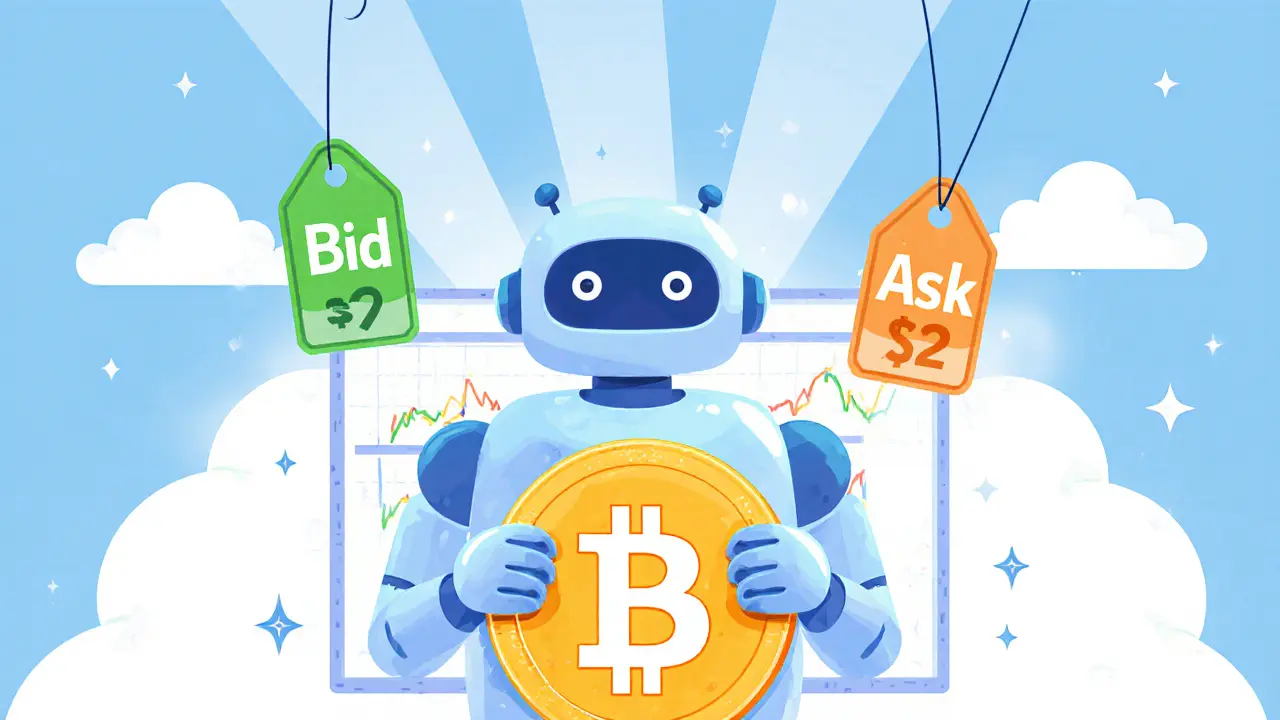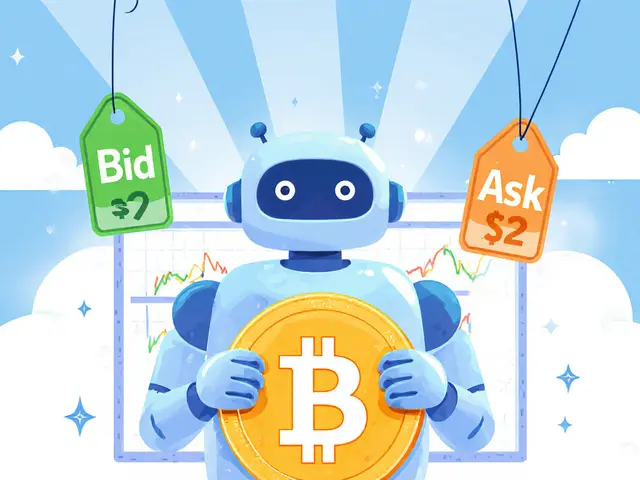Cryptocurrency Bid-Ask Spread Calculator
Spread Analysis
Enter values and click "Calculate Spread"
Spread Interpretation Guide
- Tight Spread (< 0.1%): High liquidity, low trading cost
- Moderate Spread (0.1% - 1%): Normal liquidity, acceptable cost
- Wide Spread (> 1%): Low liquidity, high trading cost
Quick Summary
- The Bid‑Ask Spread is the gap between the highest price a buyer will pay (bid) and the lowest price a seller will accept (ask) shows how liquid a crypto asset is.
- Spread percentage = (Ask-Bid) ÷ Ask×100%.
- High‑volume coins like Bitcoin usually have spreads under 0.1%, while low‑volume altcoins can see spreads above 2%.
- Market orders pay the full spread; limit orders can reduce cost but risk non‑execution.
- Choosing an exchange with tight spreads and active market makers saves money over time.
What the Bid‑Ask Spread Actually Is
When you look at any crypto trade, the Bid‑Ask Spread represents the difference between the highest price a buyer is ready to pay (the bid) and the lowest price a seller will accept (the ask) tells you how tight or wide the market is. A narrow spread means many participants are offering similar prices, which usually signals good liquidity. A wide spread hints that few traders are willing to buy or sell at comparable levels, raising transaction costs.
The two sides of the spread have their own names:
- Bid Price is the highest price a buyer is willing to pay for a cryptocurrency at a given moment.
- Ask Price is the lowest price a seller is ready to accept for the same asset.
Because the ask is always equal to or higher than the bid, the spread is never negative.
How to Calculate the Spread Percentage
The most common way to compare spreads across different coins or exchanges is to express the gap as a percentage of the ask price:
Spread% = (Ask-Bid) ÷ Ask×100%
For example, if Bitcoin’s ask is $30,200 and the bid is $30,150, the spread is $50. Plugging into the formula gives (50 ÷ 30,200)×100% ≈ 0.17%.
This simple metric lets you see whether a market is cheap to trade or whether you’ll be paying a hidden fee.
Why Liquidity Drives the Spread
Liquidity measures how easily an asset can be bought or sold without moving the price is the main factor that squeezes or widens the spread. When many buyers and sellers are active, orders pile up near each other, forcing the bid and ask to converge. When trading volume dries up, each side retreats, and the gap widens.
Data from leading exchanges shows an inverse relationship:
- Bitcoin (≈1BUSD daily volume) - average spread 0.08%.
- Ethereum (≈500MUSD daily volume) - average spread 0.12%.
- Low‑volume altcoin X (≈5MUSD daily volume) - average spread 2.4%.
This pattern mirrors traditional markets: big‑cap stocks and major forex pairs have tiny spreads, while small‑cap stocks cost more to move.

Impact on Different Order Types
Market Order executes immediately at the best available price guarantees speed but obliges you to accept the full spread. In a thin market, that can mean paying a few percent extra without realizing it.
Conversely, a Limit Order sets a specific price you’re willing to buy or sell at lets you sit between the bid and ask, potentially avoiding the whole spread. The trade‑off is uncertainty: the order may never fill if the market never reaches your price.
Both order types are also exposed to Slippage the difference between the expected execution price and the actual price caused by market movement during order processing. Slippage is especially painful when the spread is already wide, so traders often monitor both metrics together.
How Exchanges Influence the Spread
Not all Exchanges are platforms where crypto buyers and sellers meet to trade assets are created equal. Large, high‑traffic venues (e.g., Binance, Coinbase Pro) attract professional market makers who continuously post limit orders, tightening spreads. Smaller or newer exchanges lack that depth, so their spreads can be several times larger.
Below is a quick comparison of average spreads for three popular assets on three different exchanges as of October2025:
| Asset | Avg Spread (%) | 24‑hr Volume (USD) | Exchange with Tightest Spread |
|---|---|---|---|
| Bitcoin (BTC) | 0.07 | 1.2B | Binance |
| Ethereum (ETH) | 0.10 | 620M | Coinbase Pro |
| Altcoin X | 2.8 | 4.3M | Kraken (limited pairs) |
Notice how the high‑volume coins stay under 0.1% even on a single exchange, while the low‑volume altcoin struggles to get under 3%.
Practical Tips to Keep Spread Costs Low
- Always check the spread before hitting a market order, especially during volatile periods.
- Use limit orders placed just inside the spread when you can afford a short wait.
- Trade on the exchange with the highest Market Maker entity that continuously posts bid and ask quotes to provide liquidity activity for the asset you want.
- Split large orders into smaller chunks to avoid moving the price and widening the spread.
- Monitor real‑time spread charts (many platforms offer a “spread heatmap”) to spot moments when spreads narrow.
By treating the spread as a visible cost rather than an invisible fee, you can shave off a noticeable percentage from your trading results over time.
Frequently Asked Questions
Why does the spread widen during high volatility?
When price swings are large, buyers and sellers become more cautious. They move their limit orders farther apart to protect against rapid moves, which expands the gap between the highest bid and lowest ask.
Can I avoid the spread entirely?
Not completely. Even a limit order placed exactly at the midpoint still faces the risk that the market never reaches that price, causing you to miss the trade. The goal is to minimize, not eliminate, the spread cost.
Do stablecoins have tighter spreads than volatile coins?
Generally yes. Because stablecoins trade in massive volumes and have predictable price paths, most exchanges can keep their spreads under 0.02%.
How often should I check the spread before trading?
If you’re a day‑trader, check the spread on every trade. For swing or longer‑term positions, a quick glance before entering a position is enough, unless market conditions are unusually turbulent.
Is a tighter spread always better for me?
Usually, because it lowers the hidden cost of each trade. However, extremely tight spreads can also signal that large institutional market makers dominate the order book, which might make it harder for small traders to get filled at their desired price.
Takeaway
Understanding the bid ask spread is essential for any crypto trader looking to keep costs down and improve execution quality. By monitoring liquidity, choosing the right exchange, and using limit orders when feasible, you can turn a hidden fee into a manageable metric. Keep an eye on both spread and slippage, and let the numbers guide your entry and exit decisions.


Patrick MANCLIÈRE
May 9, 2025 AT 08:53When you break down the spread, think of it as the market’s hidden fee – a tiny slice that can balloon if you ignore liquidity. A tight spread signals a deep order book, meaning you can swing large positions without moving the price too much. Conversely, a wide spread is a red flag that the market is thin and your trade could cost you extra slippage. One practical tip is to always glance at the spread before you hit a market order, especially in volatile sessions when makers widen their quotes. Using limit orders just inside the current ask or bid can shave off a few basis points, but you have to be comfortable with the waiting game. Splitting a big order into several smaller chunks often prevents you from inflating the spread yourself. Also keep an eye on the exchange’s maker‑taker fee structure – sometimes the fee rebate can offset a slightly wider spread. If you’re trading a high‑volume asset like BTC or ETH on Binance, you’ll typically see spreads under 0.1%, which is a win. For altcoins with daily volume under $10M, expect 1‑3% spreads, making market orders pricey. Monitoring real‑time spread heatmaps on platforms like TradingView can highlight moments when the market tightens – those are the sweet spots for execution. Finally, remember that spread is just one side of the cost equation; combine it with slippage analysis for a full picture of your trade’s true expense.
Ciaran Byrne
May 13, 2025 AT 12:19Check the spread before each trade to avoid surprise costs.
Carthach Ó Maonaigh
May 17, 2025 AT 15:45Yo, if the spread looks like a canyon, that’s a sign you’re about to get mugged by fees. Stick to limit orders, or you’ll be paying for the privilege of getting filled.
Marie-Pier Horth
May 21, 2025 AT 19:11One must contemplate the philosophical ramifications of a widening spread; it mirrors the chaotic entropy of our digital age, where liquidity becomes a fleeting illusion.
Gregg Woodhouse
May 25, 2025 AT 22:36meh, spreads are just numbers, no need to overthink it.
F Yong
May 30, 2025 AT 02:02Sure, because ignoring a 2% spread on a low‑volume altcoin totally won’t eat your profits.
Sara Jane Breault
June 3, 2025 AT 05:28Remember to keep an eye on the spread and adjust your order type accordingly – it can make a big difference over time.
Kristen Rws
June 7, 2025 AT 08:53I always double‑check the spread before I trade, it saves me a lot of hassle.
Fionnbharr Davies
June 11, 2025 AT 12:19From a broader perspective, the spread is a micro‑indicator of market health, reflecting how many participants are willing to provide liquidity at any given moment.
Narender Kumar
June 15, 2025 AT 15:45It is of paramount importance to acknowledge the profound impact of spread variations during periods of heightened market turbulence.
Anurag Sinha
June 19, 2025 AT 19:11The spread can be a sneaky villain, especially when you’re chasing low‑cap tokens during a pump‑and‑dump cycle.
Raj Dixit
June 23, 2025 AT 22:36Always use limit orders on thin markets.
Lisa Strauss
June 28, 2025 AT 02:02Spread awareness is a small habit that leads to big savings, especially for frequent traders.
Darrin Budzak
July 2, 2025 AT 05:28Just a heads‑up: if you ignore the spread, you might end up paying more than you think.
Andrew McDonald
July 6, 2025 AT 08:53Honestly, anyone who doesn’t monitor spreads is leaving money on the table – it’s basic trading hygiene.
Enya Van der most
July 10, 2025 AT 12:19Hey folks, keep those spreads tight and your profits higher – limit orders are your friend!
Eugene Myazin
July 14, 2025 AT 15:45Spread checks are quick, they don’t hurt, and they keep your trades efficient.
Latoya Jackman
July 18, 2025 AT 19:11Monitoring spread percentages can help you fine‑tune entry timing.
Janelle Hansford
July 22, 2025 AT 22:36Spread awareness is a low‑effort habit that can boost your bottom line.
Marie Salcedo
July 27, 2025 AT 02:02Even a tiny spread difference adds up over many trades.
dennis shiner
July 31, 2025 AT 05:28Stop ignoring spreads – they’re the silent fee you can actually control.
Krystine Kruchten
August 4, 2025 AT 08:54Pay attention to spreads; they’re an essential metric for responsible trading.
Mangal Chauhan
August 8, 2025 AT 12:19One should meticulously examine the spread before executing any sizable order to preserve capital efficiency.
Iva Djukić
August 12, 2025 AT 15:45From a methodological standpoint, spread analysis augments risk assessment frameworks in crypto portfolio management.
Darius Needham
August 16, 2025 AT 19:11Always compare spreads across exchanges; the cheapest venue can save you significant fees.
carol williams
August 20, 2025 AT 22:36Keep an eye on the spread – it’s the silent leak you need to patch before it drains profits.
Maggie Ruland
August 25, 2025 AT 02:02Spread metrics are just another tool in the trader’s toolbox.
jit salcedo
August 29, 2025 AT 05:28When the spread widens, think of it as the market’s way of saying “stay back” – respect that.
Carthach Ó Maonaigh
September 2, 2025 AT 08:53Bottom line: if you’re not looking at the spread, you’re basically paying for your own stupidity.